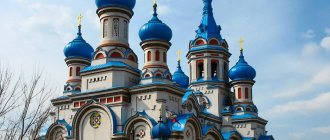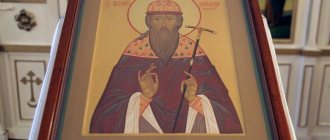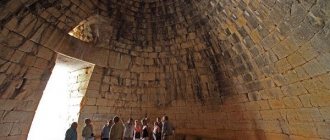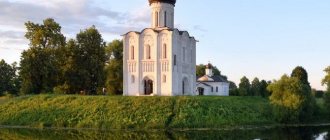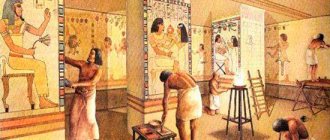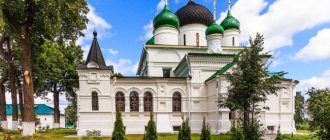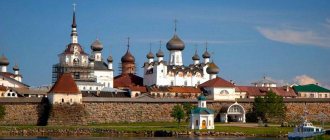Good afternoon, my dear readers. Today we will talk about the importance of monasteries in Rus'. We will also learn what role they played in the spiritual and cultural life of the people.
Monasteries appeared in Ancient Rus' shortly after her baptism. Not always, but very often, Orthodox churches were built on the site of pre-Christian sanctuaries
. In the “city of Vladimir” the most famous temple was Desyatinny. Consequently, a tenth of all “taxes” that the prince collected from his subjects went to support the church. Therefore, this is where the name of this church came from.
The first monasteries
Under Prince Vladimir there were already monasteries in Rus'. The first monasteries were founded by the Greeks, who arrived with the first metropolitan.
Therefore, with the emergence of the Kyiv-Pechersk Lavra in Rus', other monasteries began to develop. In the new center of Kyiv, two monasteries with cathedrals dedicated to St. Irene and St. George the Victorious were built. And in the 70s of the 11th century, the Dmitrov Monastery was built on St. Michael’s Hill.
In the 11th – 12th centuries, country monasteries appeared, which stretched along the banks of the Dnieper from north to south. These were the monasteries: Kirillovsky, Jordansky, Klovsky, Pechersky and Vydubitsky.
Solovetsky Monastery
Everyone has seen the Spaso-Preobrazhensky Solovetsky stauropegic monastery of the Russian Orthodox Church. There is no exaggeration in this statement - the monastery is depicted on the 500-ruble banknote. Without this simultaneously tragic and beautiful place, it is impossible to imagine the history of Russia. Today the monastery is a famous center of pilgrimage. Even those lucky ones who have been to Solovki several times and, it seems, have traveled the length and breadth of the island, coming again, are sure that discoveries await them again.
Photo by Vladimir Eshtokin
The monastery is the first attraction that everyone who arrives on Bolshoy Solovetsky Island gets acquainted with. An architectural ensemble with a 500-year history. A defensive fortress that protected the North of Russia for centuries. Here you need to examine not only the Transfiguration Cathedral and the Church of the Annunciation, the battle towers of the fortress and the one-pillar Refectory Chamber - you can examine every stone, every cage, every, even the most seemingly inconspicuous building. There is a story behind everything. And there are also monasteries, a Botanical Garden, a lighthouse temple on Sekirnaya Mountain, canals, many museums and the amazing nature of the Solovetsky Islands.
We present to you ten interesting places that a tourist should see on Solovki:
Look
Find out ten most important moments from the history of the great monastery:
To know
and ten more interesting facts about the Solovetsky Islands:
Which ones have you not heard of yet?
Monasticism in Rus'
Monasticism first appeared in Rus' after the adoption of Christianity. Although in the East and in Greece it originated much earlier.
First of all, people, dissatisfied with their previous life, left home. And they settled somewhere in a secluded place, away from the bustle of people. At first they lived alone. Gradually others joined this lonely man. As a result, monasteries (solitary dwellings) began to appear. First of all, the inhabitants of such monasteries were monks (living alone, monk).
Ferapontov Monastery
Photo: vk.com/ferapontov.monastery
Ferapontov, or rather, the Ferapontov Belozersky Nativity Monastery is both an Orthodox shrine and an object of enormous cultural significance (included, by the way, on the UNESCO World Heritage List). It is located in the Vologda region, twenty kilometers from the city of Kirillov and one hundred and twenty kilometers from Vologda. This is one of the oldest monasteries in the Russian North, founded in 1398.
It was founded by the Monk Ferapont, a student and friend of the Monk Sergius of Radonezh. The frescoes in the Ferapontov Monastery were painted by the famous icon painter Dionysius. The deposed Patriarch Nikon languished in captivity in the monastery. Now the Ferapontov Monastery is both a monastery and a museum.
For you - six interesting facts about the Ferapontov Monastery:
Read
Founders of the Kiev-Pechersk Monastery
The founders of the Kiev-Pechersk Monastery were two monks - Saint Anthony and Theodosius
. Anthony loved to travel from a young age. He was a devout and pious man. Wandering around Greece, Anthony reached the holy mountain, where there were several monasteries. He liked life in the monastery. And he wanted to become a monk. The abbot explained to him all the rules of monastic life and, after that, tonsured him as a monk. Upon returning to his homeland, Anthony settled in a secluded cave. And he began to lead a hermit’s life.
Meanwhile, when people learned about his way of life, they began to ask him to settle. Nikon was the first to settle near him, and later, in 1032, Theodosius came.
Book business
Pagan legends in Ancient Rus' were not written down, but were retold to each other - passed on from mouth to mouth. Christian teaching was transmitted in books. Therefore, with the adoption of Christianity, books came to Rus'. People needed to be introduced to new Christian ideas about the world and man, with new interpretations of history and nature...
Books were brought to Rus' from Christian countries - Byzantium, Greece, Bulgaria. Old Bulgarian and Old Russian were similar, and Russia could use the Slavic alphabet created by the brothers Cyril and Methodius.
The oldest Slavic inscriptions and manuscripts that have come down to us are composed of two graphic varieties of Slavic writing. One of them is the “Cyrillic alphabet”, named after Cyril, the second is the “Glagolic alphabet” (from the Old Slavonic “verb”, that is, “word”).
The books that existed in Rus' in the pre-Mongol period belong to three large groups: liturgical books, religious “chetya”, semi-secular and secular literature.
Under Yaroslav the Wise, they began to intensively translate literature from Greek. Monasteries were centers of book translation. First of all, liturgical books are translated: the monthly liturgical Menaion (a collection of liturgical services in calendar order for the entire year), the Triodion (collections of liturgical texts for the “Easter” cycle), liturgical books (collections of texts pronounced by the clergy during services), Trebniks (collections of ritual texts , performed during regular services outside the church), Books of Hours (collections of psalms and prayers performed at certain hours of the day). Biblical books were widely translated: the Gospel, the Apostle, the Psalter.
“Paleys” were very popular in Rus': Historical and explanatory paleys, containing a more or less complete presentation of the Old Testament history from the creation of the world.
The so-called “educational literature”—the works of Christian writers of the 3rd-11th centuries and the lives of saints—was also widely translated in monasteries. The teachings of John Chrysostom and Ephraim the Syrian became especially famous.
A special place among the books was occupied by the Apocrypha (Greek “secret” works that are not known to everyone, that is, religious works that were not recognized by the church). The Apocrypha told about the origin of “good” and “evil”, about the “end” of the world, about the “creation” of the world and man, etc.
The oldest surviving Russian books date back to the 11th century. There are a little more than two dozen of them, most of them are liturgical or religious and moral, six Menaion, four Gospels, four Psalms; lives of saints, works of the church fathers. The reason for such a small number of books was the numerous wars. Monasteries and churches remained the only protection of works from looting.
Pskov and Novgorod remained centers of book production until the 14th century. Soon new ones appeared: Tver, Rostov, Suzdal principalities. The monasteries of the Trinity-Sergius Monastery in Moscow and the Kirillo-Belozersky Monastery were famous for their book-writing workshops.
Significant cultural activity of the monks of the Solovetsky Monastery was associated with the collection of books. The priest (later hegumen) Dosifei collected a library, wrote the lives of Zosima and Savvaty, and attracted the most erudite writers of that time to create and edit manuscripts. While in Novgorod, Dositheus ordered the books to be rewritten and sent them to Solovki. Among the library books collected by Dositheus are the works of the Church Fathers of different eras, from Basil the Great and John Chrysostom to John of Damascus. Russian literature was also well represented in the collection, starting with “The Tale of Law and Grace.” For the first time in Rus', Dosifei began to mark the books of the monastic collection with a special sign - a bookplate. He also contributed to the development of book miniatures. The creation of the library was the life's work of the abbot, who made a significant contribution to the formation of the national book culture.
The Kirillo-Belozersky Monastery was founded at the end of the 14th century, and by the end of the next century its library became the largest book collection in Russia. This is evidenced, in particular, by the remarkable fact that at that time the Archbishop of Novgorod, who had at his disposal the famous Sofia Library, turned to the Belozersk monks to replenish it.
Under the leadership of Metropolitan Macarius, a grandiose literary body of an encyclopedic nature was created - the 12-volume Great Menaion of Chetya, which absorbed almost all the wealth of Russian literature of that time. The Pskov-Pechersky Monastery became a cultural center. Here the chronicle was written, books of not only church but also historical content were copied, folk songs and legends were recorded. Books from the first Moscow press were carefully kept here.
The library of the Chudov Monastery, which contained many ancient Russian rare books, was one of the most significant book depositories in Russia.
The need for books in Rus' at the time of the adoption of Christianity was very great, but there were few books. The process of rewriting the books was long and difficult. The first books were written according to the rules, or rather, they were drawn. Continuous writing appeared only in the 15th century.
It should be noted that workshops for copying books have already begun to be created in monasteries. The owners of large workshops used hired labor and hired scribes from outside. Professional scribes soon appeared, separated from the monastic workshops. They were already working to order in city squares and were called “square scribes.”
Thus, book writing gradually separated from the monasteries. There was a book factory there. However, writing was still preserved within the walls of monasteries among monks and church leaders.
Who is Theodosius
Theodosius (Fedor) was distinguished by his piety from childhood. First of all, I loved reading books and listening to readings of divine books in church. Although he grew up in a rich family, he did not like rich clothes and always walked like a beggar. Therefore, his peers did not understand him and constantly mocked him. But he bore all their ridicule in silence. His mother could not bear ridicule of her son. She began to beg him to return to his old life. But even his mother’s plea did not change his decision to become a monk. Having learned about the hermit Anthony, Theodosius came to him and began to ask to accept him. Anthony accepted him, and the priest Nikon tonsured him and named him Theodosius. And then his mother, unable to part with her beloved son, decided to become a nun herself. She became a monk at the convent of St. Nicholas. And this allowed her to be closer to her son.
Over time, the monastery where Theodosius was located expanded more and more. Consequently, the number of brethren began to increase. Thanks to the contributions and donations of parishioners, the monastery grew rich.
And Theodosius decided to build another church in honor of the Dormition of the Virgin Mary. It was founded in 1078. Grand Duke Svyatoslav donated land for this church not far from the old Pechersky Monastery. The foundation of this church was made in 1073. Theodosius died in 1074, at the age of 65, and did not live to see the completion of the church. And Anthony died a year earlier, he was 90 years old.
Clergy in the Imperial Russian Army
It should also be mentioned that in the 18th century the institution of military clergy emerged in the Russian imperial army. It also included hieromonks—priests who had taken monastic vows. In the navy, they even became the predominant category of priests, since they were not related to family and could participate in long sea voyages. The “black” military clergy existed in Russia until the First World War. Some examples of the military valor of army hieromonks can be found on the pages of the magazine “Bulletin of the Military and Naval Clergy” dated October 1, 1916. At the front in the Vilna province, the regimental priest of the 276th Kupyansky infantry regiment, Hieromonk Anatoly, voluntarily went on reconnaissance on the night of July 29 in order to encourage and reassure the soldiers with his presence. However, near the enemy's wire fences, the hieromonk was seriously wounded by an explosive bullet in the thigh, damaging the bone. For this feat, the authorities nominated Father Anatoly to the Order of St. Vladimir, 4th degree. Summing up, it is difficult to disagree with the words of the Athonite monk, abbot Alexy (Prosvirnin), who sees in warrior monks a combination of “worldly warfare” and “spiritual warfare” in their highest manifestations.
Magazine: Mysteries of History No. 43, October 2022 Category: Religions of the World Author: Timur Sagdiev
Tags: Mysteries of history, Rus', Patriotic War, Orthodoxy, Battle of Kulikovo, fortress, monastery, Dmitry Donskoy, Time of Troubles, defense, Solovki
- Back
- Forward
Assumption Church
The Assumption Church took 16 years to build. The beauty of this church amazed everyone. “The glory and adornment of the entire Russian land,” her contemporaries called her. The pilgrims who visited Kiev spread the glory of the Kiev-Pechersk Monastery throughout the land. The more the fame grew, the more pilgrims began to come here. This means that donations began to increase.
Prince Yaropolk Izyaslavovich donated three volosts to the Pechersk Monastery. And his daughter donated five villages with servants. Also, many other donations were made to the monastery. Consequently, the monastery could now conduct charity on a large scale. First of all, give shelter and food to the poor and crippled, sick and needy. The Kiev Pechersky Monastery was considered the oldest among all Russian monasteries.
Boris and Gleb Monastery
The place for it was chosen by the Monk Sergius of Radonezh himself. The monastery was a powerful fortress that protected Rus' from invasions from the West. The great monk Peresvet, who fell in the Battle of Kulikovo, labored here. From here the holy recluse Irinarch blessed the troops of Minin and Pozharsky for the liberation of Moscow from the Poles and Lithuanians. The great Russian princes and the first Russian tsars loved the Boris and Gleb Monastery and considered it their home.
Find out more about the Borisolevsky Monastery and its amazing history:
How did he become “home” for the kings?
Kyiv is a holy city
In the eyes of the Orthodox, Kyiv became a holy city. It boasted magnificent churches: Desyatinnaya and Sophia. First of all, the tomb of St. Vladimir, Equal to the Apostles, was located in the Church of the Tithes. In addition, not far from Kyiv, in Vyshgorod, there was the tomb of Saints Boris and Gleb. And on the banks of the Dnieper stood the Pechersk monastery. This monastery also contained the relics of Saints Anthony and Theodosius.
the most ancient monastery in Russia? The oldest monastery
In 1821, a monastery arose at the monastery. This event predetermined his future fate and fame. In the second quarter of the 19th century, such a phenomenon as “elderhood” arose here. Among the elders there were many educated people involved in religious and philosophical problems. The elders were visited by N.V. Gogol, F.M. Dostoevsky, L.N. Tolstoy, A.A. Akhmatova.
The Ladoga Lake Valaam archipelago is an amazing corner of Karelia. Everything here is unusual: boulders, mighty trees, rocks... Each of the ensembles has its own appearance, interesting architectural structures and agricultural buildings, dozens of chapels, crosses. In clear weather, the outlines of the archipelago are visible from afar. The architects of Valaam knew how to reveal the character of nature, and modest buildings turned into memorable landscapes. The painting of the cathedral is close to the naturalistic art of Western countries.
The emergence and initial construction of the Resurrection Monastery near Istra is associated with Nikon, a reformer of the Orthodox Church of the 17th century. Voskresenskoye was purchased by Nikon in 1656. In addition to the serfs of the patriarch himself, craftsmen from all over the country were involved in the construction. The white stone was delivered from the village of Myachkova along the Moscow River and its tributary Istra. Nikon set out to create a similarity to the Jerusalem Temple (hence the second name - New Jerusalem).
One of the most famous monasteries, Joseph-Volokolamsky , was founded at the beginning of the 15th century in the city of Volok Lamsky, known since 1135. The city was founded by Novgorodians on the site of an ancient portage (dragging overland) of ships from the Lama River to Voloshna.
Spaso-Borodinsky Monastery is one of the best monuments to the War of 1812. Architect M. Bykovsky organically integrated the fence, bell tower and tomb of General Tuchkov into the monastery.
Literature
- Russian Great Children's Encyclopedia, Modern Writer, Minsk, 2008
Geography of the monasteries
The geography of the monasteries is amazing. Sometimes they appeared in remote places, where there were only two or three villages nearby. And further, for many hundreds of miles, dense forests, swamps and untrodden lands stretched. But the ascetics of Orthodoxy penetrated there too. They settled there and carried the light of the Christian faith. And above all, they introduced the residents to the new faith.
More than fifty Incas from this monastery became bishops. Some of these Incas became abbots of other monasteries. No matter what monastery the Incas were in, they always tried to maintain the charter and spirit of the Kiev-Pechersk Monastery. At that time there were already many monasteries in Rus'. In the vicinity of Kyiv alone there were seventeen of them, male and female. Monastic life began to be considered in Rus' as a model of truly righteous life.
Spaso-Prilutsky Monastery
In 1371, in the bend of the Vologda River, the disciple of St. Sergius of Radonezh, Saint Demetrius of Prilutsky, founded the Spaso-Prilutsky Demetrius Monastery. This event had a profound impact on the development of the entire region for several centuries.
Photo: spas-priluki.ru
From the moment of its foundation, the Spaso-Prilutsky Monastery became the main outpost of the Moscow state in the North of Rus'. It is very conveniently and favorably located - at the intersection of both water and land routes. Princes and kings took care of him, seeing the Spaso-Prilutsk monastery as an important military-strategic and trade point in the North of Russia. But at the same time, the monastery has always remained the spiritual center of the Vologda region, associated with the names of great saints and with the veneration of shrines that are significant for all of Russia.
Like many other churches and monasteries, the 20th century became a tragic time for the Spaso-Prilutsk Monastery. The monastery was closed by the Soviet authorities back in the 1920s. Then there was a transit prison, warehouses, a cinema...
And in 1991, after a 67-year break, the monastery was reopened in Spaso-Prilutsky. And in 1992, the monastery was completely returned to the Russian Orthodox Church. Monastic life is being revived. Buildings are being repaired, iconostases and bells in the cathedral bell tower have been restored, and a full range of services are held daily.
Which famous poet is buried in the necropolis of the Prilutsk monastery? Why are the monastery towers so “cheerfully” painted? Read in our material:
Spaso-Prilutsky Monastery
Prince Yaroslav and the Christian faith
Vladimir died in 1015 and was then fifty-four years old.
In 1019, Prince Yaroslav, the son of Vladimir, began to rule. Zealous in the faith, caring for the welfare of his subjects, he, like his father, tried to spread the faith and Christian enlightenment. Under him, the number of dioceses increased significantly, and many churches were built in other main Russian cities. Thus, in the city of Yuryev, Yaroslav built the Church of St. George. The Church of Boris and Gleb was built in Vyshgorod.
Of the churches built under Yaroslav, the most notable were: the Cathedral Church of St. Sophia, the Wisdom of God, in Novgorod and the St. Sophia Church in Kyiv. The first temple in Novgorod burned down, and Yaroslav's son, Prince Vladimir, erected a new St. Sophia Cathedral. It was built and decorated by craftsmen from Greece. It still stands today.
First of all, the Kiev St. Sophia Cathedral, built and decorated by Greek masters, surpassed in wealth and splendor all the churches built at that time in Rus'. It was founded in honor of the victory over the Pechenegs. In addition to the St. Sophia Cathedral, Yaroslav built two churches and monasteries with them. One, Georgievsky, in the name of his angel, and the other Irininsky. It was built in honor of his wife, the daughter of the Swedish king. In addition, under Yaroslav, the Kiev-Pechersk Monastery began to be built; and under him the Novotorzhsky monastery was founded by the Monk Ephraim.
Yaroslav constantly cared about the spread of education among the people. For example, he opened a school in Novgorod, where the children of presbyters and elders studied. He also, on his own behalf, appointed special salaries to the clergy. This was done so that they would gather people around the church more often and teach them the law of God. In addition, he collected many books and founded the first significant library at the Kiev St. Sophia Cathedral.
The role of monasteries in the cultural life of Russia
Orthodox monasteries played a huge role in the cultural, political and economic history of Russia. In our country - as, indeed, in other countries of the Christian world - monasteries of monks have always been not only places of prayerful service to God, but also centers of culture and education; in many periods of Russian history, monasteries had a noticeable influence on the political development of the country and on the economic life of people.
One of these periods was the time of consolidation of Russian lands around Moscow, the time of flourishing of Orthodox art and the rethinking of the cultural tradition that connected Kievan Rus with the Muscovite kingdom, the time of colonization of new lands and the introduction of new peoples to Orthodoxy. monastery Russian icon painting painting
During the 15th and 16th centuries, the wooded north of the country was covered with a network of large monastic farms, near which the peasant population gradually settled. Thus began the peaceful development of vast spaces. It was accompanied by extensive educational and missionary activities.
Bishop Stefan of Perm preached on the Northern Dvina among the Komi people, for whom he created an alphabet and translated the Gospel. Reverends Sergius and Herman founded the Valaam Monastery of the Transfiguration of the Savior on the islands of Lake Ladoga and preached among the Karelian tribes. Reverends Savvaty and Zosima laid the foundation of the largest Solovetsky Transfiguration Monastery in the North of Europe. Saint Cyril created a monastery in the Beloozersky region. Saint Theodoret of Kola baptized the Finnish Topar tribe and created an alphabet for them. His mission in the middle of the 16th century. Saint Tryphon of Pecheneg, who founded a monastery on the northern shore of the Kola Peninsula, continued.
Many other monasteries appeared in the 15th-16th centuries. A lot of educational work was carried out, books were copied, original schools of icon painting and fresco painting were developed.
The tasks of the monasteries, in particular the Kyiv and Vladimir monasteries, and the enormous potential of such centers of feudal culture determined their activities as a higher school for the training of bishops and church administrators of the first rank in the ancient Russian principalities, which included almost all issues of the ideological, church and family life of the population of these principalities.
One of the main sources of replenishment of the monastic collections were deposits. Family heirlooms were brought here by the impoverished descendants of appanage princes who could not withstand the unequal struggle with the strengthened grand-ducal power. Contributions also came from Moscow princes and tsars, who often used influential monasteries for political purposes. The reasons for the contribution to the monastery treasury could be a victory won over an enemy, a prayer for the birth of an heir, or a solemn ascension to the throne. Often we made deposits just for the sake of our souls. On the territory of monasteries, at their cathedrals and churches, noblemen were sometimes buried, and during burial the monastery was not only paid money for the grave, but also left the personal belongings of the deceased, the icon taken from the coffin, and even the cart with horses on which it was transported. Among the donors to Russian monasteries were princes and boyars, representatives of the highest clergy, nobles, merchants and service people from different cities, “people of the sovereign’s court of various ranks,” city clerks, monastic servants and novices, artisans and peasants.
Monasteries were considered reliable repositories of national treasures. The works of art were brought here to save them. It is no coincidence that many of them were written: “And do not give it to anyone.” The most common deposits were family icons decorated with precious frames.
A significant phenomenon in the history of spiritual education was learned monasticism, although it did not immediately receive its full development. Scholarly monks usually held the positions of rectors and prefects (inspectors). It turned out that the leading administrative and pedagogical functions in the field of spiritual education were in the hands of learned monks. At the same time, work at school was, in fact, the only monastic obedience that was assigned to learned monks.
Monastic meetings in Moscow and Sergiev Posad, Rostov the Great and Suzdal, Tver and Yaroslavl were well known; in these cities unique collections of Russian icon painting of the 15th-16th centuries were collected.
Conclusion
From the above we can conclude that the Kiev-Pechersk monastery and other monasteries in Ancient Rus' helped the spread of Christianity. They also helped spread book art and education in Rus'. Prince Yaroslav gave instructions that monasteries teach people to read and write for free. And, in addition, at their own expense they maintained schools and colleges for the people. It would not be an exaggeration to say that the monasteries were the Academy of Sciences and the Academy of Arts. And, of course, the Institute of History and the Museum, the Conservatory and the Institute of Architecture at the same time. But the most important task of the monasteries was to spread the faith of Christ in Rus'. Meanwhile, in the 13th – 14th centuries there were already about 200 monasteries in Rus'. In addition to monasteries, schools began to be opened in churches.
Good health to everyone. Don't forget to subscribe to my updates.
Larisa Kolosova was with you.
V. G. Putsko. Monasteries of Ancient Rus' as a cultural phenomenon of the Middle Ages
Among the numerous Russian monasteries there were ancient ones, founded in the 11th-13th centuries. and survived eras of various national and social upheavals. There were also monasteries of Moscow Rus', which arose in the 14th-16th centuries. in different political conditions and reflecting in their structure other ideals and norms of monastic life, however, formally subordinated to the same pious intentions of personal salvation and prayerful intercession for a sinful world. However, in reality, both monasteries existed in a specific geographical and political space and were never isolated from their contemporary society, of which they remained a part under any conditions. This logically raises the question of the role of the medieval monastery in the development of national culture. A priori, one can think of it as great and exceptional, while it is difficult to reject the skeptical objections coming from supporters of the view of monasticism as a kind of abscess on the body of society. Naturally, in this state of affairs, one should appeal to specific historical facts, in most cases quite well known, although they have not been brought together to this day.
Naturally, the earliest Russian monasteries were organized on the model of the Byzantine ones, an idea of the structure of which is given by the surviving texts of their Typiks, with numerous local features, sometimes very significant.1 The history of Russian monasticism, unfortunately, does not have such an important source at its disposal.2 And therefore, the student of the cultural heritage of the Middle Ages must first of all take into account actually preserved monuments, historical material and evidence of hagiographic literature.3 Given this state of affairs, one can hardly hope for a complete coverage of phenomena. But at the same time, the noted circumstance cannot serve as a reason for refusing to address the very problem of the cultural phenomenon of the Russian Middle Ages. And some considerations, even if they are controversial, will mark a certain stage in the understanding of important and at times ambiguous phenomena that reflect the progressive development of national spiritual culture. This is the meaning of the formulated topic.
The early Kyiv monasteries were predominantly princely, and their ktitors had the opportunity to realize their ideas about the artistic appearance of the monasteries they founded.4 In the center of each of these monasteries, as a rule, stood a stone cathedral church. The nature of these structures can be judged from archaeological research data.5 The cathedral of the Vydubitsky Monastery, founded in 1070 and consecrated in 1088, has been partially preserved.6 The Cathedral of the St. Michael's Golden-Domed Monastery, built between 1108 and 1113, existed until the 1930s 7 It is famous for its mosaics made by Constantinople masters.8 The Byzantine appearance of these monastic churches, built from local materials, does not exclude the involvement of Greek architects in their creation, whose role is documented only in relation to the Assumption Cathedral of the Pechersk Monastery, founded in 1073 , completed construction in 1075.9 Although the monks of the Pechersk monastery in every possible way opposed it as created by the labors and tears of saints to the rich princely monasteries, this did not in the least prevent them from using the funds allocated by the same Kyiv princes. The real role of the latter is clearly visible in the legends of the Kiev-Pechersk Patericon against the background of the story about the miraculous calling of Constantinople architects, and later mosaicists.
The Pechersky Monastery was among the few survivors and the only one that preserved its rich historical traditions from the 11th century. One may suspect a certain bias in them, but at the same time it is difficult to ignore specific facts, partly confirmed by surviving realities. The first of these is the high educational qualification of Pechersk monks, which made it possible to nominate them to replace episcopal sees, which at the beginning of the 13th century. Vladimir Bishop Simon (1216-1226), himself a former monk of this monastery, especially noted.10
The second ability of the monks for literary work, attested to by the widely known works of St. Theodosius (c. 1036-1074)11 and Nestor,12 as well as other authors, whose works were included in the already mentioned Kiev-Pechersk Patericon. The monastery clearly had a rich library, and, according to Nestor, book writing had been practiced since the 11th century. Obviously there were manuscripts of South Slavic origin, and among them, perhaps, there was the famous Menaion of the Church with the words mainly of John Chrysostom, which later ended up in the Suprasl Monastery.13 The work of the famous icon painter Alimpiy of Pechersk, who was a direct student of the Constantinople masters, took place here.14 This is far from accidental. Nestor, in his literary work, shows an interest in art.15 In the Pechersk Monastery there were Byzantine icons,16 and church utensils made by Greek masters.17 Let this monastery be one of the few that maintained such active relations with the capital of Byzantium (it was from there that the charter was brought Studiysky Monastery), but, nevertheless, her example is indicative for determining the cultural appearance of the Kiev monastery in the most ancient period of the history of Russian monasticism.
Literary work was also carried out in other Kyiv monasteries. It is worth recalling at least the testimony of the Vydubitsky abbot Sylvester dated 111618 or the commendatory word of another abbot of the Vydubitsky monastery, Moses, included in the Hypatiev Chronicle in 1200, timed to coincide with the solemn consecration of the retaining wall built by Peter Milonego.19
In most cases, we only know about the very fact of the existence of a particular monastery from a certain time, but at the same time we are deprived of the opportunity to illuminate its life in the medieval period. The above, in particular, applies to the Yeletsky Monastery in Chernigov, the existing Assumption Cathedral of which was erected at the very beginning of the 12th century, if not in the 1090s.20 Such obviously rich monasteries could not remain aloof from the general cultural process; The combination of frescoes and stained glass in the decor of the mentioned temple itself makes one think about the place of Western elements in the real life of a Russian monastery of the Byzantine rite. In addition, the mural paintings of the Cathedral of the Nativity of the Virgin Mary in 1125 in the Novgorod monastery founded by Anthony the Roman, possibly made by Benedictine masters, also encourage.21
Rare of the early Slavic-Russian manuscripts have preserved scribes' notes, testifying to their execution in monastic book-writing workshops. All the more important are books published at the turn of the 11th-12th centuries. from the Novgorod Lazarev Monastery.2 2 Even despite their very modest graphic design, they remain valuable examples of calligraphic art. Apparently, the products of the monastery scriptoria were influenced to a certain extent by illuminated manuscripts made by masters of their craft, who were bearers of various artistic traditions, and found themselves within the walls of one or another monastery. So, in the Yuryev Monastery in Novgorod, work completed between 1119 and 1128 settled. The Gospel written by the “Ugrin”,23 and the Vygoleksensky collection of the end of the 12th century. Galician-Volhynian origin (at least the scribe was a speaker of this dialect).24 In the design of the first manuscript there are Carolingian and Romanesque decorative motifs, in the second, not yet adapted Byzantine ones, which also became widespread in the illumination of Bulgarian manuscripts. Rostov Bishop Kirill, ordained in 1216 from the monks of the Dmitrievsky Monastery in Suzdal, is known to have been a collector and owner of remarkable manuscripts, which, obviously, only partially could have followed him in 1229 to the place of his tonsure.25 From the life of St. Euphrosyne of Polotsk can be seen that book writing in the 12th century. They also practiced in nunneries.
No matter how meager and fragmentary the information given is, behind it one can still discern a fairly clearly organized cultural life of the medieval Russian monastery, designed primarily to serve the requirements of the liturgical structure inherited from Byzantium. Items of Byzantine church utensils, of course, were very desirable, but they practically could not be numerous and have widespread distribution. Therefore, they also willingly used products of Western origin,26 and, of course, items made by local craftsmen clearly predominated. In order to provide even the monasteries known by name with everything they needed, a larger number of books, icons, vestments, and various utensils, from liturgical vessels to choresses and censers, were required. Jewelry, as a rule, was the first to disappear, and therefore only a few examples are known.
The situation is somewhat better with the characteristics of the cultural appearance of Russian monasteries in the 14th and 16th centuries. The monastic architectural ensembles themselves, with their distinctive layouts, church and outbuildings, have been better preserved.27 In some cases, the interior design of monastic churches has survived, and here the iconostasis of the Trinity Cathedral of the Trinity-Sergius Lavra should be especially noted. Comparatively until recently, there were only partially disturbed libraries and sacristies, of which now the most satisfactorily preserved is the Trinity Lavra of St. Sergius, well known thanks to partly its published treasures.28 This sacristy, for all its exclusivity, can still serve as a mirror of both the development of the church art of Rus' XIV-XVI centuries. in general, and the role of monasteries in this process, in particular. Of course, not every one of the rich Russian monasteries of this period could collect at least part of such treasures within its walls. However, if we move from general admiration to a sober analysis of the materials accumulated over centuries, it turns out that they are far from equal in their artistic level. Masterpieces, naturally, are too few in number compared to the prevailing objects of artistic craft. It would seem that in the Trinity-Sergius Monastery the latter, through the efforts of local craftsmen, retained all the signs of elitism. But here, too, some disappointment awaits: Ambrose and the few carvers close to him were rather the exception. In the middle of the fifteenth century. In the monastery there turned out to be a masterly carved wooden pectoral folding cross, clearly made by one of the brilliant Constantinople masters, which was stored here back in 1928. Its carving soon began to be repeated in a simplified version in products made of wood and bone by local artisans and by the beginning of the 16th century. brought it to the point of schematism. Of course, it does not follow from this that plastic art in the monastery followed the path of degradation, but such examples were still taken into account.
In any case, medieval Russian monasteries, in terms of artistic phenomenon, retain the significance of historically established artistic treasuries, even regardless of the quantitative composition of the accumulated works. Well-known inventories and loose-leaf books give a clear idea of it.29 The things noted in them cannot always be discovered, and yet the need to prepare a publication of these treasures, which give an idea of the development of Russian sacred art of the Middle Ages as a whole, is long overdue. Along the way, it turns out that Byzantine works, it seems, mostly ended up within Rus' after 1453, when Byzantium ceased to exist, and the impoverished Greeks began to increasingly turn to their rich northern coreligionists for material help. At least, the surviving cameos, with a few exceptions, are in Russian jewelry settings of the 16th and 17th centuries, and this should not be ignored.
To date, bookmaking in Moscow and Moscow region monasteries of the 14th and early 15th centuries has been thoroughly studied. 30 And its samples, accordingly, give an idea of the calligraphic art of that time. There are also experiments in studying the handwritten products of individual scribes, such as Rev. Nil Sorsky is one of the strictest Russian ascetics of the 15th century.31 In the Christian world he is known thanks to the Rules of skete life that he compiled.32 The libraries of northern Russian monasteries were also the subject of study.33 However, the accumulated observations are clearly not enough for a general comprehensive description, and therefore the problem of a cultural phenomenon ancient Russian monasteries requires further development, involving private research. In the meantime, of necessity, we have to judge general phenomena using specific examples.
Nothing was said here about the internal structure of the monasteries, about the experiments in introducing communal regulations into them, about the large and varied economic, and at times, missionary activities. But this does not mean at all that the past of such large monasteries as Kirillo-Belozersky remains unknown to us.34 That the experiments in analyzing the internal life of the ancient Pechersky Monastery are not taken into account.35 That, finally, many important and interesting monuments of artistic culture are left without attention, including including those that have long been covered by special research. Our goal was to present a few historical facts that allow us to look at monasteries as centers of cultural life in medieval Rus'.
The social and cultural significance of these monasteries clearly varied. In some of them there were rich and carefully stocked libraries, book-writing workshops, icon painters and various artisans, whose products were carried far and wide by pilgrims. In others, poor and provincial, they had the most necessary things, and they had no idea about any masterpieces of art here. But culture lives and develops in its most varied manifestations, and even self-reading books, paying attention to singing and the daily poetic texts of prayers at daily services, was in essence an introduction to the treasures of Christian spirituality. Sometimes ordinary and inconspicuous. The general way of life, which was preserved in the living monastic tradition and in the life of the Old Believer, shows that a person, even seemingly not inclined to intellectual work, received the amount of knowledge that non-church people assimilate with great effort. Illiterate peasants who found themselves among the monastic brethren sometimes became well erudite in Scripture and patristic literature.
Universities arose quite early in Western Europe, and among Catholic monasticism a penchant for scientific pursuits was cultivated. Foreigners were sincerely perplexed why the Greeks, after the fall of Byzantium, founded universities in Italy, and not in Moscow, their co-religionist. But Moscow, with its idea of the Third Rome, turned out to be more in need of Sophia Paleologus, and a little later, the most learned Maxim the Greek appeared, and was doomed to humiliation and many years of imprisonment. And in the 16th century, as before, the function of the university was carried out by monasteries. It was from there that many writers and prominent church figures came out, not only well-read, but also with practical experience in teaching and running a complex economy. This, perhaps, most clearly reflected the cultural phenomenon of the medieval Russian monastery, the life of which was largely hidden from prying eyes. It seems that this circumstance still makes it difficult to broadly characterize the cultural activities of even those monasteries, the results of which are obvious.
1 Dmitrievsky A. Description of liturgical manuscripts stored in libraries of the Orthodox East. Kyiv, 1895. T. 1: Typika. Part 1.
2 See: Kazansky P. History of Orthodox Russian monasticism from the founding of the Pechersk Monastery by St. Anthony to the founding of the Lavra of the Holy Trinity by St. Sergius. M., 1855.
3 Putsko V. Liturgical and everyday life of a medieval Russian monastery // La vie quotidienne des moines et chanoines reguliers au Moyen Age et Temps modernes. Actes du Premier Colloque International du LARHCOR, Wroclaw - Ksiaz, 30 November - 4 December 1994. Wrozlaw, 1995. pp. 721 - 727.
4 Slyusarev V. Churches and monasteries built in Kyiv by princes, starting with the sons of Yaroslav until the end of the Kyiv Grand Duchy // Proceedings of the Kyiv Theological Academy. 12 892. T. 33. Part 1. pp. 104 - 154.
5 Summarized in the book: Rappoport P. A. Russian architecture of the X - XIII centuries. Catalog of monuments. L., 1982. (SAI. Issue E 1 - 47).
6 Ibid. P.26−27(No35).
7 Ibid. P.16−17(No18).
8 Lazarev V. N. Mikhailovsky mosaics. M., 1966.
9 Rappoport P. A. Russian architecture of the X - XIII centuries. pp. 23 - 25 (No. 33). For more details, see: Kholostenko M.V. Assumption Cathedral of the Pechersk Monastery // Ancient Kiev. Kiev, 1975. P. 107 - 170.
10 For more details, see: Voronin N.N. On the question of the beginning of the Rostov-Suzdal chronicle // Archaeographic Yearbook for 1964. M., 1965. S. 21 - 24.
11 Chagovets V. A. Life and works of St. Theodosius. Kyiv, 1901; Eremin I.P. Literary heritage of Theodosius of Pechersk // Proceedings of the Department. other Russian lit. 1947. T. V. P. 159 - 184.
12 Boguslavsky S. L. On the question of the nature and scope of the literary activity of the teacher. Nestor // Izv. Dept. rus. language and words. AN. 1914. T. XIX. Book 1. P. 131 - 186; Book 3. pp. 153 – 191.
13 Suprasalski or Retkov collection. Sofia, 1982 - 1983. T. 1 - 2.
14 Putsko N. Kiev artist of the 11th century Alimpiy Pechersky. (According to the legend of Polycarp and data from archaeological research) // Wiener slavistisches Jahrbuch. 1979. Bd. 25. pp. 63 – 88.
15 Putsko V. Some episodes from the Life of St. Theodosius of Pechersk // Old Bulgarian literature. 1990. Book. 23 - 24. pp. 57 - 62.
16 Karabinov I. A. “Regional icon” of the ancient Kiev Pechersk monastery // Izv. State Academy of Material Culture. L., 1927. T. 5. P. 102 - 113; Putsko V. Pechersk ktitor portrait // Zograf. Beograd, 1982. Book. 13. P. 42 - 48; aka. Pechersk icon of the Dormition of the Mother of God: legend and history // Roddovid. 1994. Part 9. pp. 65 - 74.
17 Putsko V. G. Cross of Mark Peschernik // SA. 1987. No. 1. P. 217 - 229.
18 Poppe A.V. About the recording of Abbot Sylvester // Culture of medieval Rus'. L., 1974. S. 51 - 52.
19 Borovsky Y. E. “Eulogous word” of Moses, hegumen of the Vidubitsky monastery // Literary decline of Kievan Rus and Ukrainian literature XVI - XVIII centuries. Kiev, 1981. pp. 54 -58.
20 Rappoport P. A. Russian architecture X - XIII centuries. P.45−46 (No. 63).
21 Putsko V. Novgorod frescoes of the 12th - 13th centuries // Wandmalerei des Hochfeudalismus im europaischbyzantinischen Spannungsfeld (12. und 13. Jahrhundert). Halle, 1983. pp. 192 - 195.
22 Yanin V.L. Novgorod scriptorium at the turn of the 11th - 12th centuries. Lazarev Monastery // Archaeographic Yearbook for 1981. M., 1982. S. 52 - 63.
23 Putsko V. Artistic decoration of the St. George’s Gospel // Ars Hungarica. 1979. No. 1. P. 7 - 21. Ill. 112.
24 Vygolensky collection. M., 1977. See fig. 1 - 29.
25 Wed: Vzdornov G.I. The art of books in Ancient Rus'. Handwritten book of North-Eastern Rus' of the 12th - early 15th centuries. M., 1980. P. 21.
26 For more details, see: Darkevich V.P. Works of Western artistic craft in Eastern Europe (X - XIV centuries). M., 1966. (SAI. Issue E 1 - 57).
27 For some of them, see: Architectural Monuments of the Moscow Region. M., 1975. T. 1 - 2; Vygolov V.P. Architecture of Moscow Rus' of the 15th century. M., 1988; Podyapolsky S.S. On the characteristics of Kirill’s architecture of the 15th-16th centuries // SA. 1966. No. 2. P.75−95; aka. Architectural monuments of the Spaso-Kamenny Monastery (XV - XVI centuries) // Old Russian art. Artistic culture of Moscow and the adjacent principalities of the 14th - 16th centuries. M., 1970. S. 437 - 457; Baldin V.I. Architectural ensemble of the Trinity-Sergius Lavra. M., 1976.
28 See: Nikolaeva T.V. Works of small sculpture from the 13th to 17th centuries in the collection of the Zagorsk Museum. Catalog. Zagorsk, 1960; she is the same. Old Russian painting of the Zagorsk Museum. M., 1977; Olsufiev Yu. A. Inventory of ancient church silver b. Trinity-Sergius Lavra. Sergiev, 1926.
29 See for example: List of the acquired images of all ranks of weight gain selected in 722 in the Pokrovsky nunnery // Proceedings of the Vladimir Scientific Archival Commission. Vladimir, 1908. Book. X; Inset book of the Trinity-Sergius Monastery. M., 1987; Inset book of the Serpukhov Vysotsky Monastery. M., 1993; Inventory of Savvin the Watchtower Monastery of the 17th century. M., 1994.
30 Vzdornov G.I. Book writing and artistic design of manuscripts in Moscow and Moscow region monasteries until the end of the first third of the 15th century. // Interaction of literature and fine arts of Ancient Rus'. M.; L., 1966 (TODRL. T. XXII). pp. 119 – 143.
31 Prokhorov G. M. Autographs of Nil Sorsky // Cultural Monuments. New discoveries. 1974. M., 1975. S. 37 - 54.
32 Our venerable and God-bearing father Nil of Sorsky and his Charter on monastic life... M., 1991.
33 Kukushkina M.V. Monastic libraries of the Russian North. Essays on the history of book culture of the 16th - 17th centuries. L., 1977. See also: Book centers of Ancient Rus'. Joseph-Volokolamsk Monastery as a center of book learning. L., 1991.
34 Nikolsky N.K. Kirillo-Belozersky Monastery. St. Petersburg, 1897, 1910. T. 1 - 2.
35 See: Priselkov M.D. Essays on the church-political history of Kievan Rus X - XII centuries. St. Petersburg, 1913.
← Back | Forward →
Return to the “Cave of the Three Magi”
But in 491, Emperor Anastasius reigned in Constantinople, supporting the Monophysites, condemned by the IV Ecumenical Council (Monophysitism is a heresy that claims that Christ had only one nature - Divine, which allegedly completely absorbed the human, while Orthodoxy professes the doctrine of the two natures of Jesus Christ - Divine and human), and persecution began against the Orthodox. There were riots throughout the empire. The Monk Theodosius, on behalf of the hermits, wrote a letter to the emperor, denouncing him of heresy.
At this time, the emperor, under the pressure of external and internal political circumstances, was forced to relent for a while. But soon the persecution of the Orthodox resumed, and then the elder, leaving the monastery, came to Jerusalem and in the Great Church, standing on a dais, loudly proclaimed: “Whoever does not honor the four Ecumenical Councils, let him be anathema.” For this insolence he paid with imprisonment, from which he was released only after the death of the emperor.
The Monk Theodosius died on January 11 (January 24, new style) 529, at the age of 105 from birth. The body of the saint was buried with honor in the cave in which he lived at the beginning of his feat - the “cave of the three wise men.”


